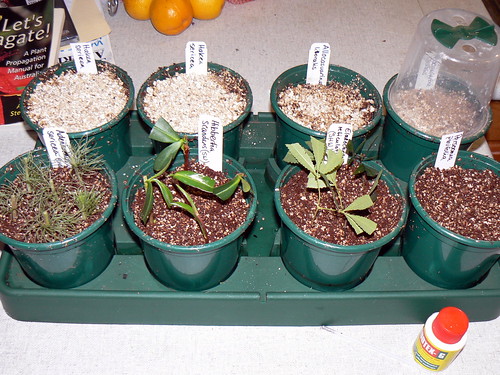Pottering in the garden on a weekend is great when it's fine, but today it's raining so I did my gardening in the kitchen, propagating the seeds I recently collected as well as doing some cuttings from plants in the garden.
This tray is something I picked up a few years ago, and it is brilliant for propagating both seed and cuttings. The pots have lids (see top right) that allow you to keep the seedlings or cuttings protected, as well as regulating water loss. The pots sit on sponges which you keep wet, and the soil draws up moisture as needed.
So the
Allocasuarina littoralis and
Hakea sericea seeds you might remember from
my previous post. I've made cuttings of three other plants:
The first is
Adenanthos sericea, Albany Woolly Bush, a West Australian species I'm growing in a pot. It's getting a bit large for the pot and a little tired, so some offspring are timely. As you can see from the photos in the link above, it looks like its leaves should be sharp and tough like those of
Hakea sericea, but in fact they're soft and delicate. It's a very beautiful shrub/tree.
Next is
Hibbertia scandens, a local twiner which propagates from cuttings very easily. It flowers year round--I took this photo this afternoon.
And finally,
Elaeocarpus reticulatus, Blueberry Ash, which produces either white or pink flowers and bright blue berries, beloved of birds. As you can see, we have the white flowered variety.
All these cuttings are semi-hardwood. That means it's not the most recent growth, nor old growth, but something in between that still has vigor but is more substantial than the new growth used in soft-tip cuttings. Autumn is the best time for semi-hardwood cuttings.
As a propagating mix, I used 1:1 peat moss and
vermiculite, a quite versatile and handy mineral that assists in ensuring that the growing medium is well aerated. I also use it to cover seeds when they're sown, to gently hold them down and keep them moist.
When you're making cuttings, it's important to make your final cut at the bottom just below a node. The node is where the meristematic tissue is--basically, the same as embryonic stem cells in humans, able to differentiate into a variety of cell types. When you're doing cuttings, you want them to become root cells.
It's also wise to remove most of the leaves, and cut half to two thirds off the remaining. Some leaves are needed so the plant can still photosynthesise, but plants transpire (lose water) through their leaves, and for a plant with no roots, water is at a premium. For the same reason, you need to keep their environment humid.
Humidity, of course, brings its own problems, mainly in the form of fungal infection. Whenever I propagate with cuttings or seeds, I first wash all my pots in a dilute solution of bleach, then rinse. "Damping off" is a form of fungal disease that can easily kill tiny seedlings, the stems essentially being eaten away.
To give your cuttings a high chance of success, rooting hormone is a good idea. This is basically auxin, a plant hormone. Auxin's quite remarkable stuff. It is found in the shoot and root tips of plants, and its presence there ensures that tip's dominance, and suppresses the growth of competitors. When you remove the main shoot of a plant (by tip pruning, for example), that suppression ceases, and the apical buds in the nodes (near where the leaves attach to the stem) then begin to grow new shoots. Thus by tip pruning, you can make your plant nice and bushy, especially if you begin tip pruning when they're still very young . Applying auxin to the basal cut of a cutting stimulates root growth there--especially if it's just below a node.
Now I know you're just aching to know how the dreaded
Persoonia pinifolia seeds I talked about
last post are coming along. Hmm. Not great.
Having soaked them for a couple of days, I tried breaching the endocarp, and succeeded in cutting the embryo in half. Whoops. This photo shows just how solid and relatively thick the endocarp is!
 Scale: 1mm.
Scale: 1mm.There were three seeds left, but I stupidly left them on the kitchen counter in a bowl. My husband just got home and cleaned up.... Well, we rescued two from the sink. This is clearly the downside of kitchen bench propagation.
I'm going to attempt to file off the endocarps. I may be gone for some time....
Edited to add: If you're interested in propagating native plants, I couldn't recommend this book more highly. Angus Stewart's "Let's Propagate: A Plant Propagation Manual for Australia". Not only does he provide good advice on methods, he also has a comprehensive listing of Australian plant genera, and what method works best with each.










